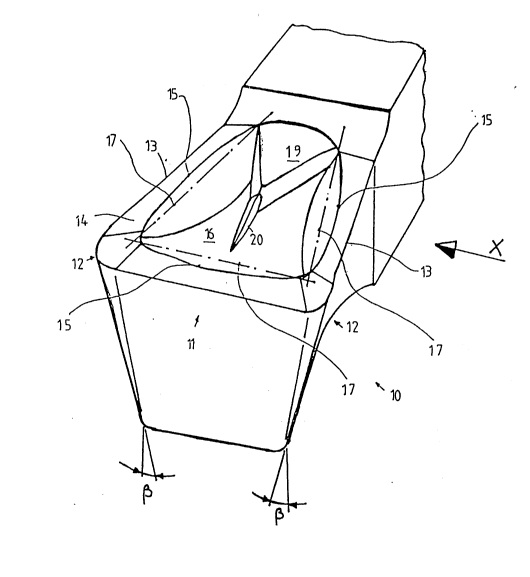Note: Claims are shown in the official language in which they were submitted.
Patent claims
1. A cutting insert (10, 23) in particular for radial
machining such as tapping, turn broaching, turn-turn-
broaching, milling or cutting screwthreads, but also for
turning, at the cutting edges (11, 13) with a negative
cutting surface lane (14, 141, 142) which width is maximum
in at least one cutting edge corner or in the region of a
round main cutting edge,
characterized in that
the border (15) between the cutting surface land (14, 27,
141, 142, 143) and the adjacent cutting surface (16) in
the direction of the cutting edge (11, 13, 18) adjacent to
the cutting surface land and linear seen in a side view
- runs through a sole depression in the shape of a minimum
space per main cutting edge (11) and/or secondary cutting
edge (13) or
- at cutting inserts with a round or partitial round cutting
edge (28) seen in a top view,
- there are several depressions in the shape of a minimum
space which have an angular distance from the neighboured
or opposite depression of 90° or 180°.
2. The cutting insert according to claim 1, characterized in
that the border (15) between the cutting-surface land (14,
141 through 143, 27) and the cutting surface (16) extends
generally arcuateley.
3. The cutting insert according to one of claims 1 or 2,
characterized in that the cutting-surface land angle (.alpha.)
from one cutting corner (12, 24) out toward the cutting
edge (13) has different negative land angles (.alpha.1 through
.alpha.3).
8a
4. The cutting insert according to claim 3, characterized in
that the land angle (.alpha., .alpha.2 through .alpha.3) changes
continuously, preferably continuously toward zero, but
always negatively.
5. The cutting insert according to one of claims 1 through 4,
characterized in that the border (15) between the cutting
surface (14) and the cutting surface (16) is of wavy
and/or zig-zag shape, at least one of the upper or of the
lower containing curves forming an arc with uniform
curvature.
6. The cutting insert according to one of claims 1 through 5,
characterized in that in a tapping tool (10) the main
cutting edge (11) and/or the secondary cutting edge (13)
has cutting-surface lands (14).
7. The cutting insert according to claim 6, characterized in
that the main cutting-surface land (14) is formed
symmetrically between the adjacent cutting corners (12)
and the secondary cutting-surface lands (13) relative to
the longitudinal central axis of the tapping tool (10)
and/or a perpendicular thereto.
8. The cutting insert according to one of claims 1 through 7,
characterized in that the cutting-surface lands (14, 141,
142, 143) are formed perpendicular to the cutting
edge (11, 13) straight, convex, concave, with one or more
chip-forming grooves (25) and/or with one or more chip-
forming elements (26).
9. The cutting insert according to one of claims 1 through 8,
characterized in that a chip-guiding step is arranged
immediately at the cutting-surface land (14, 141, 142,
143).
10. The cutting insert according to one of claims 1 through 9,
characterized in that the cutting surface (16) has a
raised chip breaker (19) with a projecting rib-shaped
wedge (20) with a tapering point directed in the
longitudinal direction.
11. The cutting insert according to one of claims 1 through 6
and 8 through 10, characterized in that the cutting insert
is a thread-cutting insert (23) with staggered and stepped
adjacent cutting edges (24)
with the cutting-surface lands (14) each running through a
minimum of a projecting cutting corner to the cutting-edge
bump.
12. The cutting insert according to one of claims 1
through 11, characterized in that the free angle (.beta.) is
positive or 0°.
13. The cutting insert according to one of claims 1 through 6,
8 through 10, and 12 characterized in that the cutting
insert has a closed circular cutting edge (28) and that
the border (15) between the negative land (27) and the
adjacent cutting surface runs through maximum and minimum
spacings from the cutting edge (28).
14. The cutting insert according to claim 13, characterized in
that the border runs through at leat four maximum levels
and four minimum levels.
15. The cutting insert according to claim 13 or 14,
characterized in that wedge-shaped longitudinal-rib raised
chip-forming elements are provided extending radially from
the minimum spacings of the border (15) from the cutting
edge (28).
